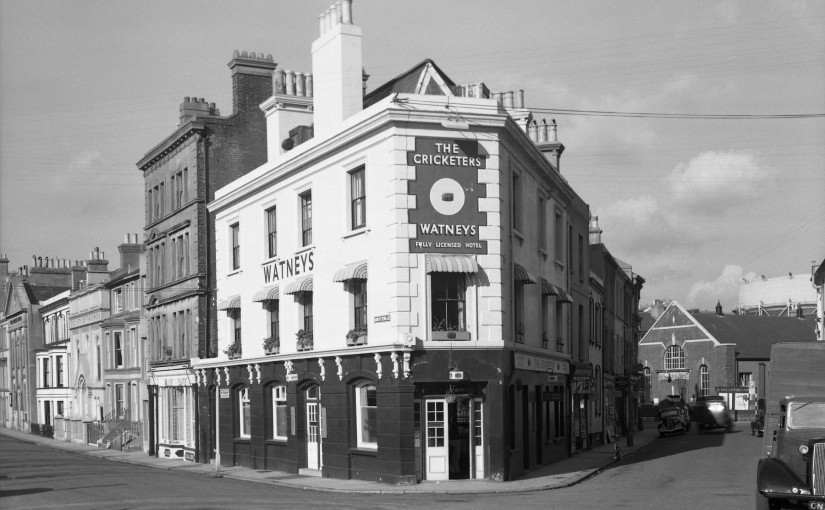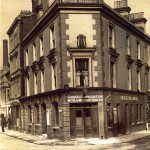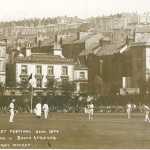By John Hodges
Sometime early in the nineteenth century Hastings began to expand out of what we now know as The Old Town, that still to this day nestles between its guardian hills. But before this westward expansion could take place substantial removal of the projecting Castle Cliffs had to be accomplished, a formidable precursor to a policy of continual development. Once this cliff had been removed the way was open to the development of Wellington Square which began from around 1817 onwards, providing elegant homes for the great and the good of the day, whilst Meadow Cottages and Blucher Buildings lower down the Priory Valley, provided for the lesser needs of the artisan classes.
Probably the first of the major achievements in the cause of populating the Priory Valley came in 1830 with development of a gasworks in the northern part of the valley. In 1836 the second of the activities directed towards the growth of the Valley as a centre for population was introduced, this included the draining of the lower end by the culverting of the Priory Stream. But probably the most significant addition to its potential for expansion came with the railway reaching Hastings in 1851. The coming of the railway to Hastings not only boosted the local economy, but it also significantly changed the topography of the Priory Valley by the construction of a massive earth embankment. This was necessary because of the continuing marshy nature of much of the ground, a condition that can be traced back to its one time inundation by the sea.Much land in the Priory Valley at this time was still regarded as good meadow land and the siting of Priory Farm and the subsequent cultivation of much of the upper part of the valley as Hop Gardens bore witness to this fact. Hops together with malted barley and water, and the addition of yeast are the vital ingredients in the brewing of beer. But hops are normally grown only in river valleys where late Summer and Autumnal mists that form around their roots in the early morning, are essential to their development. The Priory Valley and its stream provided such conditions, whilst the end product once dried and pressed was eagerly taken up by the local brewers. The decision in 1836 by the Town Council to drain the lower part of the valley, then known as the Priory Marshes, was to encourage the development that would bridge the void between Old Hastings in the East and the new town of St. Leonards in the West.
The coming of the railways in 1851 coupled with the availability of this newly drained building land signalled the development of modern Hastings as we know it today, a blend of back street worker’s cottages and middle class town villas. One such typical project was the construction of South Terrace in the early 1860’s a truly Victorian Paradox, consisting of elegant villas, the Quakers Meeting House in the middle, and a Hotel at either end. These two Public Houses which still stand today are the Cricketers and the Prince’s Hotel. The Cricketers a hostelry that for many years traded in the colours of Watney, Combe, Reid has found fame over the years from its feature in Robert Tressell’s magnificent exposure of a system whereby philanthropists in the ragged clothes of the working class, willingly hand over the meagre results of their labour to the employers and the idle rich. Here in the Cricketers, he observed some of its unsuspecting customers, symbolised in his book as the “Semi-drunk and the Besotted Wretch” through the inebriation that offered the one escape that many of the working class had from the iniquities of Edwardian life. There appears in Robert Tressell’s great work a very full description of the internal arrangement of the pub, and some of the games and entertainment through which these poor wretches wiled away their unproductive hours.
Quite where the Cricketers obtained its earliest alcoholic supplies is unclear, with some certainty we can say that they were not brewed on the premises. By far the closest brewery, at the time of opening, was Harriett Cheal’s Castle Brewery in Stonefield Road, but a more likely source would have been one of the Old Town establishments with the largest of them, Thomas Breeds, already supplying a significant number of local outlets. The first owning brewers that documented evidence exists were Chandler’s Wiltshire Brewery of Hackney Road, Bethnal Green. And it would have been beers produced by this company that Robert Tressell would have enjoyed during the visits he made to the Cricketers during his time in Hastings. In 1911, this house together with the thirteen others that were owned by Chandlers in Hastings , was sold off with the rest of the company and acquired by Watney, Combe, Reid & Co. Hastings represented an important trading area for this company, and this statement can be verified by the fact that when the rationing of beer accompanied the start of the First World War, the Hastings depot was one of only four provincial establishments that were not sold off by Watneys in their bid to protect the supply of beer to their London houses. From 1911 the Cricketers continued to trade under the Watney’s banner, with the only changes being in the various marketing names depending upon the part of the UK where an outlet was located. In 1996 the pub was sold off by Watneys and it became The Priory, while the rest of the Watney’s Group by now had been further integrated into the massive Grand Metropolitan empire. How this conglomerate could get even bigger seemed impossible, but just to confound the world of hotels and pub chains it merged with Guinness in 1997 to form Diageo.
In the meantime The Priory also failed to maintain its initial momentum as a successful town centre pub, and closed. Briefly another pub opened in the premises but this too succumbed to commercial pressures from the ever increasing off licence trade, leaving only the Princes, which is now the very successful Pissarros , to cater for the thirst of this part of Hastings. The Cricketers went on to become a music orientated eating house evocatively named Blue Jazz, and finally became a gambling establishment, the Hastings Terrace Club. As I write the Cricketers stands empty and lifeless, a million miles away from even the alcohol influenced dialogue that played such a distractive part in Robert Tressell’s wonderful expose of working conditions in Edwardian Hastings.
Rye’s Own May 2014
All articles, photographs and drawings on this web site are World Copyright Protected. No reproduction for publication without prior arrangement.


